Sun Joe 24V-MDTCR1-LTW Handleiding
Bekijk gratis de handleiding van Sun Joe 24V-MDTCR1-LTW (60 pagina’s), behorend tot de categorie Detector. Deze gids werd als nuttig beoordeeld door 77 mensen en kreeg gemiddeld 4.5 sterren uit 39 reviews. Heb je een vraag over Sun Joe 24V-MDTCR1-LTW of wil je andere gebruikers van dit product iets vragen? Stel een vraag
Pagina 1/60

© 2021 by Snow Joe
®, LLC
All rights reserved. Original instructions. SAVE THESE INSTRUCTIONS
1
A Division of Snow Joe
®, LLC
OPERATOR’S MANUAL
Model 24V-MDTCR1-LTW Form No. SJ-24V-MDTCR1-LTW-880E-M
RCORDLESS METAL DETECTOR
24V MAX* | 1.3 Ah | 10-INCH SEARCH COIL
EN
IMPORTANT!
Safety Instructions
All Operators Must Read These
Instructions Before Use
Always follow these safety guidelines. Failure to do so may
result in serious bodily injury or death.
General Safety WARNINGS!
When using this cordless metal detector, basic safety
precautions should always be followed. These precautions
include:
mWARNING! This metal detector is only for use with
Snow Joe® + Sun Joe® iON+ 24V series batteries.
mWARNING! Do not use with any other accessory or
attachment not approved or manufactured by Snow Joe® +
Sun Joe®.
Before using the metal detector, take the time to familiarize
yourself with all the controls. Only use the metal detector once
you have a thorough understanding of the instructions and
know how to operate the machine.
Retain this manual for future reference.
1. Usage – Do not use the metal detector for any
applications other than those for which it was intended.
2. Do not overreach – Keep proper footing and balance at
all times.
3. Prevent unintentional starting – Ensure the switch is
in the o-position before connecting the battery pack,
picking up the device, or carrying the device.
4. Remove the battery – Disconnect the battery pack
from the metal detector before making any adjustments,
changing any accessories, or storing the device.
5. Store idle metal detector indoors – When not in use, the
metal detector should be stored indoors in a dry, locked
place.
6. Maintain with care – Inspect the metal detector
periodically and if damage is found have it repaired by an
authorized service facility. Keep handles dry, clean, and
free from oil and grease.
Additional Safety Instructions for
Metal Detector
When searching with your metal detector, observe these
precautions:
1. Never trespass or hunt on private property without
permission.
2. National and state parks/monuments and military zones,
etc. are absolutely o-limits.
3. Avoid areas where pipelines or electric lines may
be buried. If found, do not disturb and notify proper
authorities.
4. Use reasonable caution while detecting or digging,
particularly if you are uncertain of the conditions.
5. If you are unsure about using your metal detector in any
area, always seek permission from the proper authorities.
Metal Detecting Ethics Code
The following is a code of ethics that many treasure hunters
follow. We encourage you to do the same:
1. Respect private and public property as well as all
historical and archaeological sites. Do not metal detect on
these lands without proper permission.
2. Keep informed on and obey all local and national
legislation relating to the discovery and reporting of found
treasures.
3. Aid law enforcement ocials whenever possible.
4. Do not cause any willful damage to any property, including
fences, signs and buildings.
5. Always ll the holes you dig.
6. Do not destroy property, buildings or the remains of
deserted structures.
7. Do not leave litter or any other discarded items lying
around.
8. Carry all rubbish and discovered artifacts with you when
leaving each search area.

2
Electric Safety
mWARNING! Read all safety warnings and instructions.
Failure to follow the warnings and instructions may result in
electric shock, re and/or serious injury.
1. Recharge only with the charger specied by the
manufacturer. A charger that is suitable for one type of
battery pack may carry a risk of re if used with another
battery pack.
2. When the battery pack is not in use, keep it away from
other metal objects, like paper clips, coins, keys, nails,
screws or other small metal objects, that can make a
connection from one terminal to another. Shorting the
battery terminals together may cause burns or a re.
3. Under abusive conditions, liquid may be ejected from the
battery; avoid contact. If contact accidentally occurs, ush
with water. If liquid contacts eyes, seek additional medical
help. Liquid ejected from the battery may cause irritation
or burns.
4. Do not expose the battery pack or device to re or
excessive temperature. Exposure to re or temperatures
above 265ºF (130ºC) may cause explosion.
5. Follow all charging instructions and do not charge the
battery pack or device outside of the temperature range
specied in the instructions. Charging improperly or at
temperatures outside of the specied range may damage
the battery and increase the risk of re.
Battery & Charger Safety
Instructions
We pay a great deal of attention to the design of every battery
pack to ensure that we supply you with batteries that are safe,
durable and have a high energy density. The battery cells have
a wide range of safety devices. Each individual cell is initially
formatted and its electrical characteristic curves are recorded.
This data is then used exclusively to be able to assemble the
best possible battery packs.
Despite all the safety precautions, caution must always be
exercised when handling batteries. The following points must
be obeyed at all times to ensure safe use. Safe use can only
be guaranteed if undamaged cells are used. Incorrect handling
of the battery pack may cause cell damage.
IMPORTANT! Analyses show that incorrect use and poor care
of high-performance batteries are the main factors responsible
for personal and/or product damage.
mWARNING! Use only approved replacement batteries;
other batteries may damage the metal detector and cause it to
malfunction, which can lead to re or serious personal injury.
mWARNING! Do not use the battery pack or device if
damaged or modied. Damaged or modied batteries may
exhibit unpredictable behavior resulting in re, explosion or
risk of injury.
mWARNING! Do not modify or attempt to repair the
appliance or the battery pack except as indicated in the
instructions for use and care.
mWARNING! Have your battery pack serviced by a
qualied repair person using only identical replacement
parts. This will ensure that the safety of the battery pack is
maintained.
mCAUTION! To reduce the risk of injury, charge the
Sun Joe® 24V lithium-ion battery pack only with the provided
charger or the chargers shown in the optional accessories
panel. Other types of chargers present risk of re, personal
injury and damage. Do not connect the battery pack to an
unspecied power supply or 12V DC car charger. Such misuse
may permanently disable or damage the battery pack.
• Avoid dangerous environments – Do not charge the
battery pack in rain, snow or in damp or wet locations.
Do not use or charge the battery pack in the presence
of explosive gases, fumes, dust or ammable materials.
Sparks may be generated when inserting or removing the
battery pack, which could lead to a re.
• Charge in a well-ventilated area – Do not block the
charger vents. Keep them clear to allow for proper
ventilation. Do not allow smoking or open ames near a
charging battery pack. Vented gases may explode.
The safe temperature range for the battery is 41°F – NOTE:
105ºF (5°C – 40.5°C). Do not charge the battery outside in
freezing weather; charge it at room temperature.
• Maintain charger cord – When unplugging the charger,
pull the plug, and not the cord from the AC power outlet to
reduce the risk of damage to the electrical plug and cord.
Never carry the charger by its cord or yank it by the cord
to disconnect it from the AC power outlet. Keep the cord
away from heat, oil and sharp edges. Make sure the cord
will not be stepped on, tripped over or subjected to damage
or stress when the charger is in use. Do not use the charger
with a damaged cord or plug. Replace a damaged charger
immediately.
• Do not use an extension cord unless it is absolutely
necessary – Using the wrong, damaged or improperly
wired extension cord poses a risk of re and electric shock.
If an extension cord must be used, plug the charger into a
properly wired 16 gauge or larger extension cord with the
female plug matching the male plug on the charger. Make
sure that the extension cord is in good electrical condition.
• Use only recommended attachments – Use of any
attachments not recommended or sold by the manufacturer
may result in a risk of re, electric shock or personal injury.
• Unplug charger when not in use.
mWARNING! To reduce the risk of electric shock,
always unplug the charger before performing any cleaning
or maintenance. Do not allow water to ow into the charger.
Use a Ground Fault Circuit Interrupter (GFCI) to reduce shock
hazards.

3
• Do not burn or incinerate battery pack – Battery packs
may explode, causing personal injury or damage. Toxic
fumes and materials are created when battery packs are
burned.
• Do not crush, drop or damage battery pack – Do not use
the battery pack or charger if they have sustained a sharp
blow, been dropped, run over or have been damaged in any
way (i.e. pierced with a nail, hit with a hammer, stepped on,
etc.).
• Do not disassemble – Incorrect reassembly may pose
a serious risk of electric shock, re or exposure to toxic
battery uid. If the battery or charger are damaged,
contact an authorized Snow Joe® + Sun Joe® dealer or
call the Snow Joe® + Sun Joe® customer service center at
1-866-SNOWJOE (1-866-766-9563) for assistance.
• Battery chemicals cause serious burns – Never let a
damaged battery pack contact the skin, eyes or mouth. If
a damaged battery pack leaks battery uid, use rubber or
neoprene gloves to safely dispose of it. If skin is exposed to
battery uids, wash the aected area with soap and water.
If eyes are exposed to battery chemicals, immediately
ush with water for 20 minutes and seek medical attention.
Remove and dispose of contaminated clothing.
• Do not short circuit – When battery pack is not in use,
keep it away from other metal objects, like paper clips,
coins, keys, nails, screws or other small metal objects
that can make a connection from one terminal to another.
Shorting the battery terminals together may cause burns or
a re.
• Store your battery pack and charger in a cool, dry
place – Do not store the battery pack or charger where
temperatures may exceed 105ºF (40.5ºC), such as in direct
sunlight or inside a vehicle or metal building during the
summer.
Information about the battery
1. For optimum battery performance, avoid low discharge
cycles by charging the battery pack frequently.
2. Store the battery pack in a cool place, ideally at 77°F
(25°C) and charged to at least 40%.
3. Lithium-ion batteries are subject to a natural aging
process. The battery pack must be replaced at the latest
when its capacity falls to just 80% of its capacity when
new. Weakened cells in an aged battery pack are no
longer capable of meeting the high power requirements
needed for the proper operation of your metal detector.
4. Do not completely discharge batteries. Exhaustive
discharges will damage the battery cells. The most
common cause of a complete discharge is lengthy storage
of partially discharged batteries. Stop working as soon
as the performance of the battery falls noticeably or the
electronic protection system triggers. Place the battery
pack in storage only after it has been fully charged.
5. Protect the battery pack and the tool from overloads.
Overloads will quickly result in overheating and cell
damage inside the battery housing even if this overheating
is not apparent externally.
6. Avoid damage and shocks. Immediately replace batteries
that have been dropped from a height of more than
3 feet (1 meter) or those that have been exposed to violent
shocks, even if the housing of the battery pack appears to
be undamaged. The battery cells inside the battery may
have suered serious damage. In such instances, please
read the waste disposal information for proper battery
disposal.
7. If the battery pack suers from overloading and
overheating, the integrated protective cuto will switch o
the equipment for safety reasons.
IMPORTANT! Do not press the power supply button any
more if the protective cut-o has been activated. This may
damage the battery pack.
Information about the charger and the
charging process
1. Please check the data marked on the rating plate of the
battery charger. Be sure to connect the battery charger
to a outlet matching voltage specied on the rating plate.
Never connect it to a dierent mains voltage.
2. Protect the battery charger and its cord from damage.
Keep the charger and its cord away from heat, oil and
sharp edges. Have damaged cords repaired without delay
by a qualied technician at an authorized Snow Joe® +
Sun Joe® dealer or call the Snow Joe® + Sun Joe®
customer service center at 1-866-SNOWJOE
(1-866-766-9563).
3. Electrical plugs must match the outlet. Never modify
the plug in any way. Do not use any adapter plugs with
grounded appliances. Unmodied plugs and matching
outlets will reduce the risk of electric shock.
4. Keep the battery charger, battery pack and the appliance
out of the reach of children.
5. During periods of heavy use, the battery pack will become
warm. Allow the battery pack to cool to room temperature
before connecting with the charger to recharge.
6. Do not overcharge batteries. Do not exceed the maximum
charging times. These charging times only apply to
discharged batteries. Frequent insertion of a charged or
partially charged battery pack will result in overcharging
and cell damage. Do not leave batteries in the charger for
days on end.
7. Never use or charge the battery if you suspect that it has
been more than 12 months since the last time they were
charged. There is a high probability that the battery pack
has already suered damage (exhaustive discharge).
8. Charging batteries at a temperature below 41°F (5°C) will
cause chemical damage to the cells and may cause a re.
Product specificaties
| Merk: | Sun Joe |
| Categorie: | Detector |
| Model: | 24V-MDTCR1-LTW |
Heb je hulp nodig?
Als je hulp nodig hebt met Sun Joe 24V-MDTCR1-LTW stel dan hieronder een vraag en andere gebruikers zullen je antwoorden
Handleiding Detector Sun Joe

9 Mei 2023

13 April 2023
Handleiding Detector
- Dahua Technology
- Velleman
- Resideo
- Smartwares
- Inovonics
- Gossen
- Kyoritsu
- Uniden
- Joy-it
- Gewiss
- ZKTeco
- Maginon
- SureCall
- Garmin
- X4-Tech
Nieuwste handleidingen voor Detector
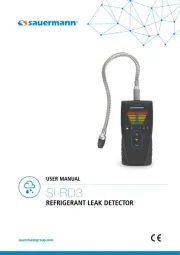
1 September 2025

20 Augustus 2025
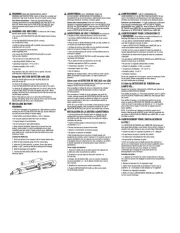
18 Augustus 2025
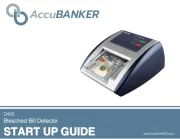
12 Augustus 2025
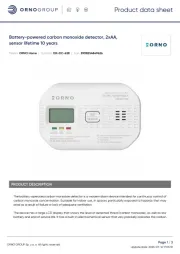
11 Augustus 2025
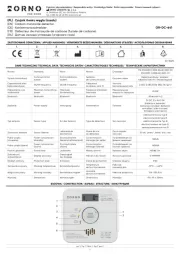
11 Augustus 2025
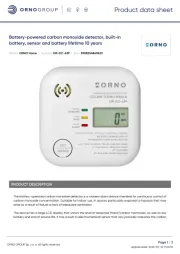
11 Augustus 2025
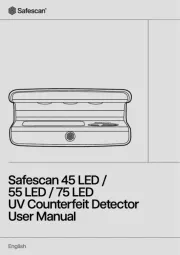
8 Augustus 2025
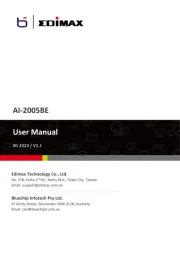
28 Juli 2025
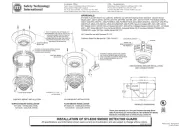
24 Juli 2025